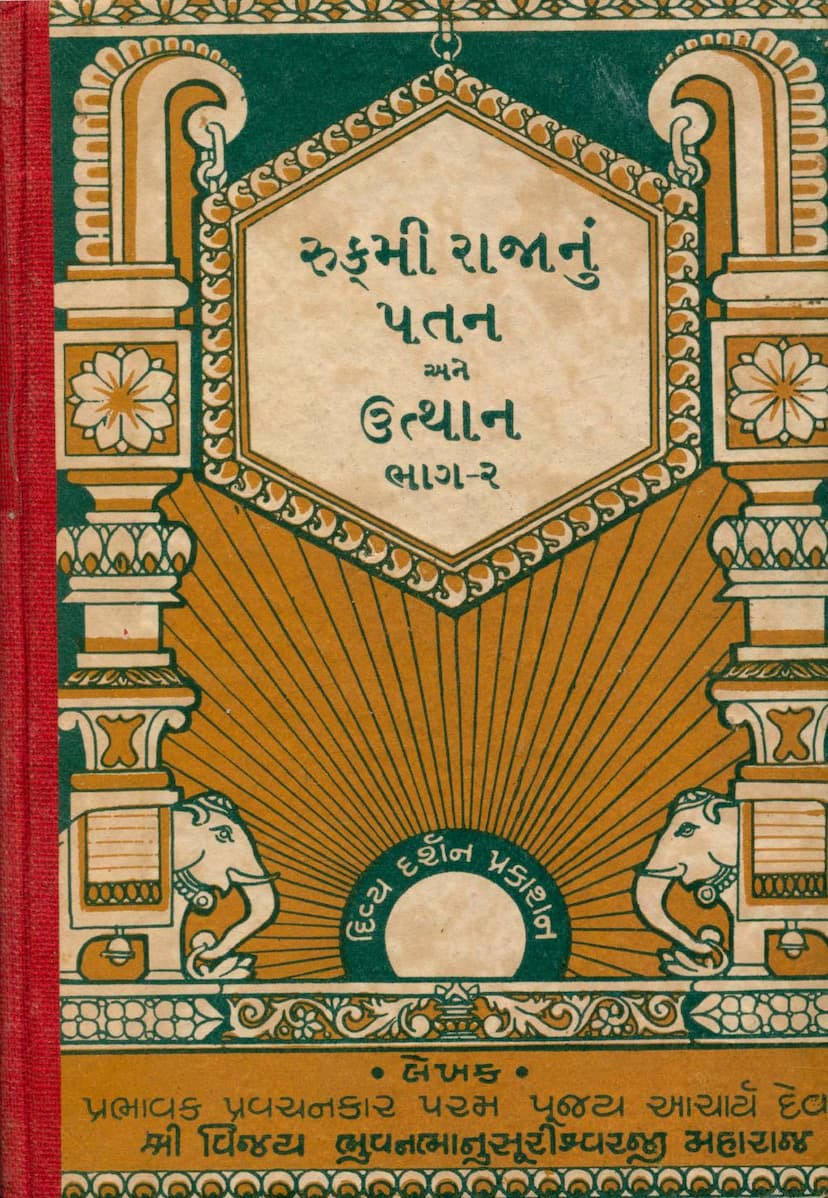Rukmi Rajanu Patan Ane Utthan Part 02
Added to library: September 2, 2025

Summary
The provided Jain text, "Rukmi Rajanu Patan Ane Utthan Part 02" by Acharya Shri Vijay Bhuvanbhanusurishwarji Maharaj, published by Divyadarshan Trust, is the second part of a narrative focusing on the rise and fall of King Rukmi.
The book continues the story from its first part. The preface highlights that the first volume was well-received by readers who found guidance and solutions to their life's dilemmas within it. This second volume promises to offer even more profound insights, providing spiritual solace and mental peace.
Key Narrative Points from the Preface and Table of Contents:
-
Rukmi's initial dilemma: In Part 1, Rukmi, a princess, becomes a widow shortly after marriage. Overwhelmed by youthful passion and a desire to avoid bringing shame to her family, she asks her father to let her immolate herself on a pyre. Her father advises her that life is an opportunity for good deeds and that suicide is not the answer. He suggests that controlling youthful impulses can be achieved through renunciation, penance, self-control, good company, and chastity, leading her to become a great Brahmacharini (a celibate woman).
-
Rukmi becomes queen: Following the death of her father, the king, who had no male heir, her ministers, impressed by the power of her Brahmacharya, urged her to become queen.
-
Rukmi's temptation: In Part 2, the story progresses. A foreign prince, hearing of Rukmi's chastity, visits her court. However, this time, Rukmi is captivated by the prince's beauty and looks at him with desire. The prince, sensing her impure intentions, immediately leaves.
-
Prince's resolution: The prince reflects on his own handsome physique, lamenting that it caused the renowned Brahmacharini Rukmi to falter. He resolves to renounce his body, not through immediate suicide, but through controlled fasting, penance, and meditation, to achieve peace at death and utilize his life for self-improvement.
-
Further narrative: The book then delves into Rukmi's further downfall despite her previous adherence to chastity, detailing the tragic consequences and her eventual spiritual upliftment after experiencing profound suffering and introspection.
-
Extensive Topical Coverage: The book is characterized by its detailed exploration of various spiritual and ethical topics relevant to Jain philosophy. These are elucidated through numerous examples, arguments, and illustrations. The table of contents reveals a vast range of subjects, including:
- The power of virtuous intentions and their impact on character development.
- The importance of patience, forgiveness, and tolerance.
- The four pillars of character growth.
- Precautions in accumulating good deeds.
- The essence of guru devotion.
- Methods to change negative thought patterns.
- Contemplation for various situations.
- Ways to cultivate a noble mind, including self-awareness and compassion.
- The perspective on others being beneficial or detrimental.
- The significance of friendship in Dharma.
- Overcoming attachment to material possessions.
- The benefits of hopeful contemplation.
- The reasoning behind the Lord's voluntary suffering in adverse regions.
- The twelve contemplations to avoid corruption.
- Attributing fault to the father rather than destiny when deceived.
- The essential nature of life.
- Seeking refuge in the Arhat.
- The importance of virtues and character.
- The mindset and path for chastity.
- Six methods to avoid misconduct.
- The paradoxical nature of the world and the cycle of karma.
- Eight contemplative reflections.
- Seven excuses for not adopting asceticism, with their solutions.
- Five methods to attract Dharma.
- The importance of adhering to Jain teachings.
- The benefits of silence and effective speech.
- Stopping the urge to speak unnecessarily.
- The foundation of self-elevation and strong relationships in non-violence.
- The nature of the soul bound to rebirth.
- The essence of Jain identity.
- The meaning of arduous vows and austerities.
- Reasons why good advice might not be effective.
- Flaws in incorrect perceptions.
- The duties of self-reliance.
- The path to renunciation and liberation.
- The influence of desires and the pursuit of true happiness.
- The true development of the modern era versus the past.
- The practices of Chakravarti Muni.
- Overcoming pride in spiritual practice.
- Resolving the perception of auspicious and inauspicious.
- Protecting oneself from greed.
- The benefits of compassion.
- Methods for developing wisdom.
- The root of modern crimes and thefts.
- The effectiveness of prayer instead of complaint.
- The nature of the world.
- The remarkable speech of Govinda's wife, the Brahmin woman.
- The supportive nature of Dharma as a friend, peace-giver, and strength-enhancer.
- The essence of Namokar mantra.
- How to cultivate faith in Dharma.
- The rarity of Dharma opportunities.
- Eleven duties to overcome negligence.
- The difficulty of great vows.
- Ten reasons why good advice may fail.
- The shortcomings in understanding Dharma.
- Advice to sons.
- Three duties for self-strength.
- The promptness of renunciation upon developing detachment.
- The liberation of Rukmi and the Brahmins through initiation, and the power of women.
-
Illustrative Examples: The book draws upon numerous well-known stories and figures from Jain tradition and history, such as Chandanbala, 1500 ascetics, Samara-aditya, Marubhuti, Dharam-chintal, Meghkumar, Dhanna, Mahabal, Shalibhadra, Ajitasen, Shala-Mahashala, Prasannachandra, Nagketu, Mahavir, the painter's daughter and son, Brahmi-Sundari, the widow's daughter, Hitler, Shashbhav, Rahiniya Char, Marichi, Nadishen, Abhaykumar, Zanjhariya Muni, Bharat Senapati, Sushrenu, Shrenik, and many others.
The author's intent is to provide teachings that are not only enlightening but also practically applicable to daily life, fostering right thinking, speech, and conduct. The book aims to help readers understand the profound principles of Jainism and extract valuable lessons from the story of Rukmi, thereby purifying their minds and enabling them to discern good from bad in their own lives. It emphasizes the importance of avoiding faults that lead to downfall and encourages continuous spiritual progress.
The book concludes with an acknowledgment of the assistance provided by Muni Shri Rajendra Vijayji Maharaj and Padmasen Vijayji Maharaj in its publication.